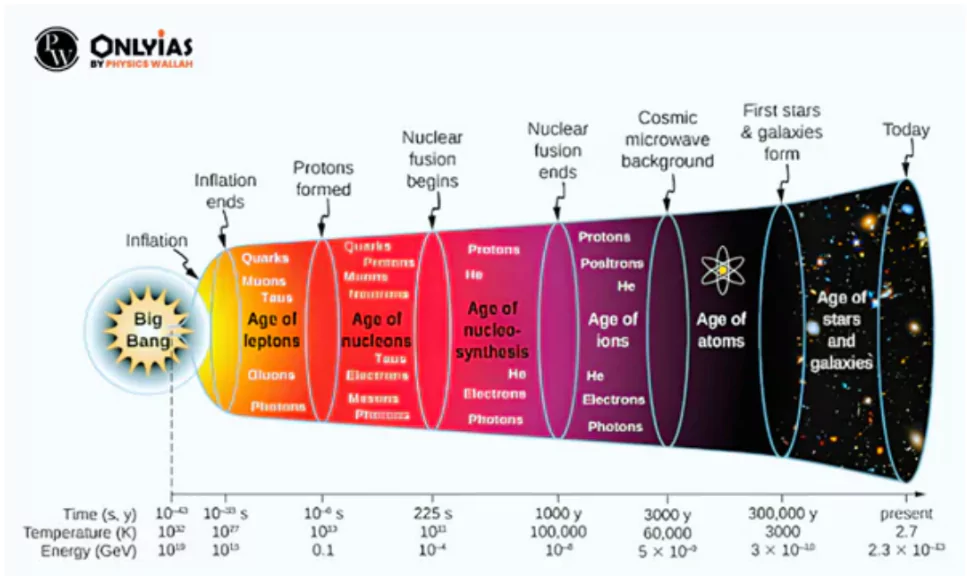Images from the James Webb Space Telescope (JWST) are puzzling– instead of newborn galaxies, the early phases of the Universe appear to be full of adult-sized galaxies.
- Also, the rate at which the Universe is expanding, as measured by the space telescope, also differs from expectations.
About the Expansion of the Universe
This concept of expansion of the Universe was first proposed by Georges Lemaitre in the 1920s and later supported by Edwin Hubble’s observations.

- Refers: It refers to increasing distance between galaxies over time, leading to the stretching of space itself.
- Evidence for Cosmic Expansion:
- Hubble’s Law: It states that galaxies are receding from us, with their redshift proportional to their distance, indicates universal expansion.
- Redshift: When an object is moving away from us, the light from the object is known as redshift.
- Blueshift: When an object is moving towards us, the light from the object is known as blueshift.
- Cosmic Microwave Background (CMB): An echo of the Big Bang, the CMB radiation is uniformly distributed and provides evidence of the universe’s early hot and dense state.
- Large-Scale Structure: Observations of the distribution of galaxies and galaxy clusters show a web-like structure, consistent with an expanding universe.
Enroll now for UPSC Online Classes
Ways to Measure Expansion
The rate of expansion of the Universe has been a subject of scientific debate for quite some time. Two different methods of determining the rate have yielded results that differ by as much as 10%.
- On the basis of Phenomena in the early Universe: It implies events at a great distance, because the light we see from distant objects started its journey a long time ago.
- On the basis of Local Celestial Objects: This method relies on local celestial objects, although ‘local’ means a region spanning billions of light years.
- Some stars vary their brightness in a periodic manner, and the duration of this change tells us something about how bright they really are. It helps in figuring out their distance and, in turn, how the Universe has been expanding.
- Role of JWST: The new space telescope was expected to find the reason for the mismatch between the results obtained by the two methods.
- But its measurements seem to have only increased the discrepancy. Its deeper inspection of the local method of measurement gives a rate of expansion that is somewhat faster than that based on early Universe measurements.
- Reliability: The early Universe method relies on relic radiation from the primeval epochs, when the Universe was hot. The radiation has now cooled down as the Universe has expanded, and has become a microwave ‘hum’ that pervades everything.
- A detailed analysis of this radiation can tell us how fast the Universe has been expanding.
- One method depends on how well we know our stars, and the other on how well we understand the history of the Universe.
Standard Model of the Universe
Over the decades, a ‘standard model’ of the Universe has emerged, which is appealing in its simplicity, and also flexible enough to accommodate complexity.
- Find out: Based on it, a history of the Universe has been sketched out — barring the very first moment, which remains elusive.
- Need for: This model has needed quick fixes in more than one aspect. Faced with a mismatch between the inventory of matter and the observed pull of gravity, scientists have invented “dark matter”, although no one has any idea what it is made of.
-
- Dark matter takes up space and holds mass like normal matter, but it doesn’t reflect, absorb, or radiate light (not detected yet).
- Comprehensive Revision: Some astronomers have begun to think that the gaps in the understanding may not be just a matter of details and may warrant a comprehensive revision of the thinking of the Universe.
- There have been occasions in the history of science when scientists have held on to existing ideas by introducing patchwork to accommodate contradictions between theory and observations.
- Example: Greeks kept introducing complexities to the orbits of planets around the Earth, disregarding suggestions that their basic geocentric model of the Universe was wrong.
About James Webb Telescope
The James Webb Space Telescope is an orbiting infrared observatory that will complement and extend the discoveries of the Hubble Space Telescope, with longer wavelength coverage and greatly improved sensitivity.
- Developed by: NASA with the assistance of the European Space Agency and the Canadian Space Agency
- Launched in: It was launched in 2021, with the mission duration of 5-10 years
- Location in Space: It is placed at Lagrange point 2, approximately 1.5 million km beyond Earth’s orbit around the Sun.
- Lagrange Points are positions in space where the gravitational forces of a two-body system like the Sun and Earth produce enhanced regions of attraction and repulsion.
- Size: Webb’s primary mirror is approximately 6.5 metres in diameter, giving it a significantly larger collecting area than the mirrors of the current generation of space telescopes.
- Wavelength: It will provide wavelength coverage from 0.6 to 28 microns (the infrared part of the electromagnetic spectrum).
- Objectives:
- Search for the first galaxies and luminous objects formed after the Big Bang.
- Determine how galaxies evolved from their formation until now.
- Observe the formation of stars from the first stages to the formation of planetary systems.
- Measure the physical and chemical properties of planetary systems, including our own Solar System, and investigate the potential for life in those systems.
Check Out UPSC NCERT Textbooks From PW Store
![]() 19 Aug 2024
19 Aug 2024

